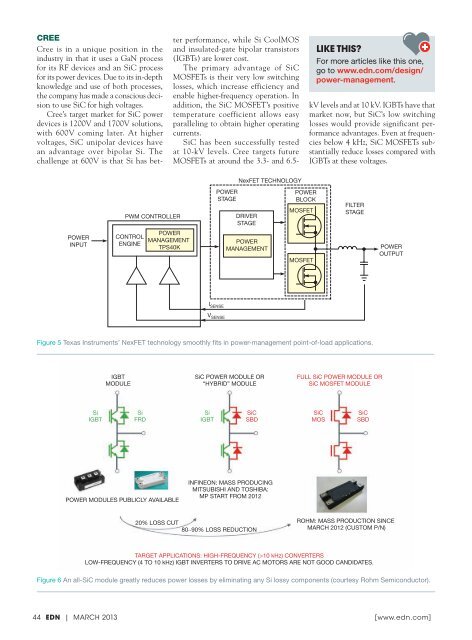201303.pdf 36567KB Mar 22 2013 09:11:22 PM
201303.pdf 36567KB Mar 22 2013 09:11:22 PM
201303.pdf 36567KB Mar 22 2013 09:11:22 PM
You also want an ePaper? Increase the reach of your titles
YUMPU automatically turns print PDFs into web optimized ePapers that Google loves.
Cree<br />
Cree is in a unique position in the<br />
industry in that it uses a GaN process<br />
for its RF devices and an SiC process<br />
for its power devices. Due to its in-depth<br />
knowledge and use of both processes,<br />
the company has made a conscious decision<br />
to use SiC for high voltages.<br />
Cree’s target market for SiC power<br />
devices is 1200V and 1700V solutions,<br />
with 600V coming later. At higher<br />
voltages, SiC unipolar devices have<br />
an advantage over bipolar Si. The<br />
challenge at 600V is that Si has better<br />
performance, while Si CoolMOS<br />
and insulated-gate bipolar transistors<br />
(IGBTs) are lower cost.<br />
The primary advantage of SiC<br />
MOSFETs is their very low switching<br />
losses, which increase efficiency and<br />
enable higher-frequency operation. In<br />
addition, the SiC MOSFET’s positive<br />
temperature coefficient allows easy<br />
paralleling to obtain higher operating<br />
currents.<br />
SiC has been successfully tested<br />
at 10-kV levels. Cree targets future<br />
MOSFETs at around the 3.3- and 6.5-<br />
LikE This?<br />
For more articles like this one,<br />
go to www.edn.com/design/<br />
power-management.<br />
kV levels and at 10 kV. IGBTs have that<br />
market now, but SiC’s low switching<br />
losses would provide significant performance<br />
advantages. Even at frequencies<br />
below 4 kHz, SiC MOSFETs substantially<br />
reduce losses compared with<br />
IGBTs at these voltages.<br />
NexFET TECHNOLOGY<br />
POWER<br />
INPUT<br />
PWM CONTROLLER<br />
CONTROL<br />
ENGINE<br />
POWER<br />
MANAGEMENT<br />
TPS40K<br />
POWER<br />
STAGE<br />
DRIVER<br />
STAGE<br />
POWER<br />
MANAGEMENT<br />
POWER<br />
BLOCK<br />
MOSFET<br />
MOSFET<br />
FILTER<br />
STAGE<br />
POWER<br />
OUTPUT<br />
I SENSE<br />
V SENSE<br />
Figure 5 Texas Instruments’ NexFET technology smoothly fits in power-management point-of-load applications.<br />
IGBT<br />
MODULE<br />
SiC POWER MODULE OR<br />
“HYBRID” MODULE<br />
FULL SiC POWER MODULE OR<br />
SiC MOSFET MODULE<br />
Si<br />
IGBT<br />
Si<br />
FRD<br />
Si<br />
IGBT<br />
SiC<br />
SBD<br />
SiC<br />
MOS<br />
SiC<br />
SBD<br />
POWER MODULES PUBLICLY AVAILABLE<br />
INFINEON: MASS PRODUCING<br />
MITSUBISHI AND TOSHIBA:<br />
MP START FROM 2012<br />
EDN1303CS Fig 8.eps<br />
20% LOSS CUT<br />
80∼90% LOSS REDUCTION<br />
DIANE<br />
ROHM: MASS PRODUCTION SINCE<br />
MARCH 2012 (CUSTOM P/N)<br />
TARGET APPLICATIONS: HIGH-FREQUENCY (>10 kHz) CONVERTERS<br />
LOW-FREQUENCY (4 TO 10 kHz) IGBT INVERTERS TO DRIVE AC MOTORS ARE NOT GOOD CANDIDATES.<br />
Figure 6 An all-SiC module greatly reduces power losses by eliminating any Si lossy components (courtesy Rohm Semiconductor).<br />
44 EDN | <strong>Mar</strong>ch <strong>2013</strong> [ www.edn.com ]






![[270].pdf 37407KB Sep 02 2010 09:55:57 AM - ElectronicsAndBooks](https://img.yumpu.com/50350834/1/185x260/270pdf-37407kb-sep-02-2010-095557-am-electronicsandbooks.jpg?quality=85)
![draaien, A Viruly 1935 OCR c20130324 [320]. - ElectronicsAndBooks](https://img.yumpu.com/49957773/1/190x252/draaien-a-viruly-1935-ocr-c20130324-320-electronicsandbooks.jpg?quality=85)



![20051110 c20051031 [105].pdf 35001KB Feb 18 2009 08:46:32 PM](https://img.yumpu.com/48687202/1/190x253/20051110-c20051031-105pdf-35001kb-feb-18-2009-084632-pm.jpg?quality=85)





